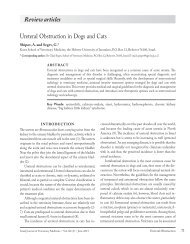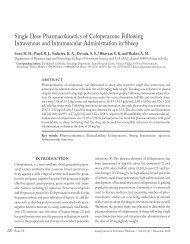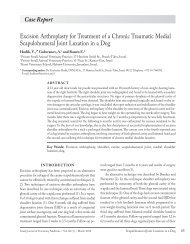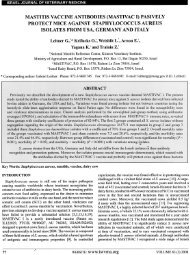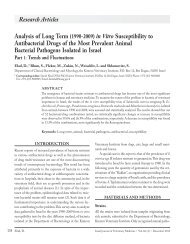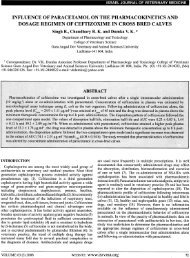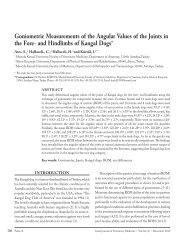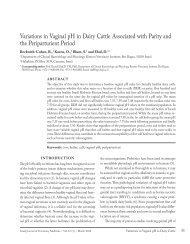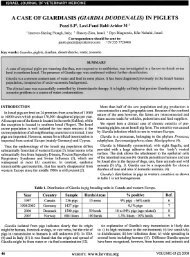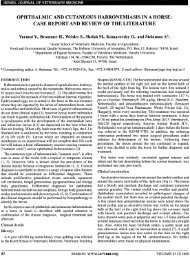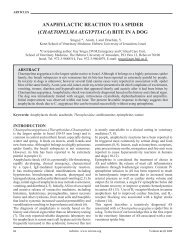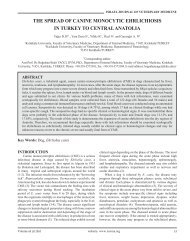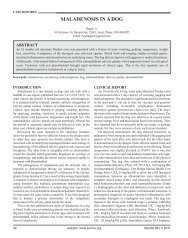A Novel Modified Semi-direct Method for Total Leukocyte Count in ...
A Novel Modified Semi-direct Method for Total Leukocyte Count in ...
A Novel Modified Semi-direct Method for Total Leukocyte Count in ...
Create successful ePaper yourself
Turn your PDF publications into a flip-book with our unique Google optimized e-Paper software.
Research Articles<br />
There<strong>for</strong>e, many veter<strong>in</strong>arians refer blood samples to reference<br />
laboratories. However, leukocytes may distort if analysis<br />
is delayed (5, 6). In such cases, prolonged exposure to ethylenediam<strong>in</strong>e<br />
tetraacetic acid (EDTA) anticoagulant may<br />
cause erythrolysis, viscosity changes and leukocyte morphology<br />
alterations <strong>in</strong> blood samples of crowned cranes, crows,<br />
jays, brush turkeys, hornbills, magpies and some ratites (5,<br />
7).In-cl<strong>in</strong>ic blood smear evaluation has several advantages: it<br />
is cost-efficient, samples are fresh, avoid<strong>in</strong>g time-dependent<br />
deterioration and morphologic artifacts (5) and results are<br />
obta<strong>in</strong>ed and <strong>in</strong>terpreted immediately, thereby promot<strong>in</strong>g<br />
early diagnosis and treatment.<br />
The DLC <strong>in</strong> non-mammalian species is per<strong>for</strong>med by<br />
count<strong>in</strong>g 100-200 leukocytes <strong>in</strong> sta<strong>in</strong>ed blood smears, and<br />
has been studied mostly <strong>in</strong> the domestic chicken (Gallus gallus)<br />
(1). In non-mammalian species, differentiation between<br />
eos<strong>in</strong>ophils and heterophils, small lymphocytes and thrombocytes,<br />
and large lymphocytes and monocytes is often difficult<br />
(4). Eos<strong>in</strong>ophil granule color varies between species<br />
of parrots and iguanas, from red to light blue, purple or grey<br />
and depends on the sta<strong>in</strong><strong>in</strong>g type and technique (1, 8, 9, 10).<br />
The total leukocyte count (TLC) <strong>in</strong> non-mammalian<br />
vertebrates can be counted us<strong>in</strong>g three methods; 1) <strong>direct</strong><br />
hemocytometer count<strong>in</strong>g with Natt and Herrick's or toluid<strong>in</strong>e<br />
blue sta<strong>in</strong> solutions (1, 7, 11, 12); 2) semi-<strong>direct</strong> hemocytometer<br />
count with phlox<strong>in</strong>e-B dye or the (now discont<strong>in</strong>ued)<br />
commercial eos<strong>in</strong>ophil Unopette 5877 (Becton<br />
- Dick<strong>in</strong>son, Ruther<strong>for</strong>d, NJ) (1, 3, 8, 11-14), comb<strong>in</strong>ed with<br />
manual DLC <strong>in</strong> Romanowsky-sta<strong>in</strong>ed blood smears (4, 516,<br />
17); 3) <strong>Semi</strong>-quantitative TLC evaluation <strong>in</strong> Romanowskysta<strong>in</strong>ed<br />
blood smears, which is considered less accurate (1,<br />
3). The latter can be done by averag<strong>in</strong>g leukocyte number<br />
<strong>in</strong> 10 monolayer, X400 fields and multiply<strong>in</strong>g it by 2000,<br />
yield<strong>in</strong>g the TLC <strong>in</strong> cell/µL. Alternatively, one can determ<strong>in</strong>e<br />
the leukocyte average number <strong>in</strong> five X1000 monolayer<br />
fields, multiply it by 3,500,000 (the approximate number of<br />
erythrocytes <strong>in</strong> 1 µL of blood <strong>in</strong> birds when the packed cell<br />
volume (PCV) is 35-55%), and divid<strong>in</strong>g the result by 1000<br />
(the average number of erythrocytes <strong>in</strong> 5 X1000 monolayer<br />
fields). The result should be corrected if PCV is abnormally<br />
high or low (1, 3, 4).<br />
Direct leukocyte count is a complex, time-consum<strong>in</strong>g<br />
procedure, <strong>in</strong>volv<strong>in</strong>g preparation of the sta<strong>in</strong> solution, and is<br />
complicated by the need to differentiate lymphocytes from<br />
thrombocytes, and with presence of sta<strong>in</strong>ed erythrocytes<br />
<strong>in</strong> the hemocytometer (1, 4, 5). The semi-<strong>direct</strong> count<strong>in</strong>g<br />
method relies on the positive sta<strong>in</strong><strong>in</strong>g of heterophils and eos<strong>in</strong>ophils<br />
by the dye, allow<strong>in</strong>g their count<strong>in</strong>g <strong>in</strong> the hemocytometer.<br />
Calculat<strong>in</strong>g their total number per microliter, and<br />
then the TLC is achieved by per<strong>for</strong>m<strong>in</strong>g a DLC us<strong>in</strong>g a<br />
Romanowsky-sta<strong>in</strong>ed blood smear. This method is more precise<br />
and less time consum<strong>in</strong>g than the <strong>direct</strong> hemocytometer<br />
count (1, 3, 4, 8); however, it becomes progressively less accurate<br />
<strong>for</strong> estimation of the TLC with <strong>in</strong>creas<strong>in</strong>g proportion<br />
of mononuclears to granulocytes (1). Currently, the Unopette<br />
5877 kit has been discont<strong>in</strong>ued (Ady Gancz, personal communication),<br />
while the other sta<strong>in</strong><strong>in</strong>g solutions mentioned<br />
are not readily available <strong>in</strong> most veter<strong>in</strong>ary cl<strong>in</strong>ics. In contrast,<br />
Romanowsky-based quick sta<strong>in</strong><strong>in</strong>g solutions are readily<br />
available and are used <strong>in</strong> many veter<strong>in</strong>ary cl<strong>in</strong>ics <strong>for</strong> blood<br />
smear sta<strong>in</strong><strong>in</strong>g. Based on the sta<strong>in</strong><strong>in</strong>g aff<strong>in</strong>ity of heterophils<br />
and eos<strong>in</strong>ophils, eos<strong>in</strong>-based sta<strong>in</strong><strong>in</strong>g solutions are expected<br />
to sta<strong>in</strong> these cells similarly as phlox<strong>in</strong>e-B.<br />
The aim of the present study was to evaluate a modified<br />
semi-<strong>direct</strong> method <strong>for</strong> TLC (MSDTLC) <strong>in</strong> non-mammalian<br />
blood, us<strong>in</strong>g a diluted eos<strong>in</strong>-based dye, <strong>in</strong>cluded <strong>in</strong><br />
a Romanowsky-based quick sta<strong>in</strong> ( J-322A-2, Jorgensen<br />
Laboratories Inc. Loveland, Colorado, USA), which is readily<br />
available, <strong>in</strong>stead of phlox<strong>in</strong>e-B as the sta<strong>in</strong><strong>in</strong>g diluent,<br />
and to assess its accuracy and variability.<br />
MATERIALS AND METHODS<br />
Selected animals and blood samples collection<br />
Blood samples were collected from the jugular or brachial<br />
ve<strong>in</strong>s <strong>in</strong> lithium-hepar<strong>in</strong> pediatric tubes (M<strong>in</strong>iCollect,<br />
Gre<strong>in</strong>er, Gre<strong>in</strong>er Bio-One North America, Inc., Monroe,<br />
NC), from 13 psittac<strong>in</strong>e birds (Table 1) presented to the<br />
Hebrew University Veter<strong>in</strong>ary Teach<strong>in</strong>g Hospital, Beit<br />
Dagan, and to The Exotic Cl<strong>in</strong>ic, Herzeliya. Blood smears<br />
were prepared immediately, and later sta<strong>in</strong>ed us<strong>in</strong>g a<br />
Romanowsky-based sta<strong>in</strong> (modified Wright's solution).<br />
Assessment of the ideal sta<strong>in</strong><strong>in</strong>g solution dilution and<br />
blood cell sta<strong>in</strong><strong>in</strong>g and hemocytometer count<strong>in</strong>g<br />
Four different dilutions of the dye ( J-322A-2) were tested,<br />
<strong>in</strong> distilled water, and <strong>in</strong> sal<strong>in</strong>e (1:5, 1:10, 1:25 and 1:50) to<br />
sta<strong>in</strong> a s<strong>in</strong>gle fresh blood sample obta<strong>in</strong>ed <strong>in</strong> lithium-hepar<strong>in</strong><br />
from a parrot which was presented to the hospital at the time<br />
the study was <strong>in</strong>itiated. The blood was exam<strong>in</strong>ed with<strong>in</strong> five<br />
112<br />
Aroch, I.<br />
Israel Journal of Veter<strong>in</strong>ary Medic<strong>in</strong>e • Vol. 68 (2) • June 2013



